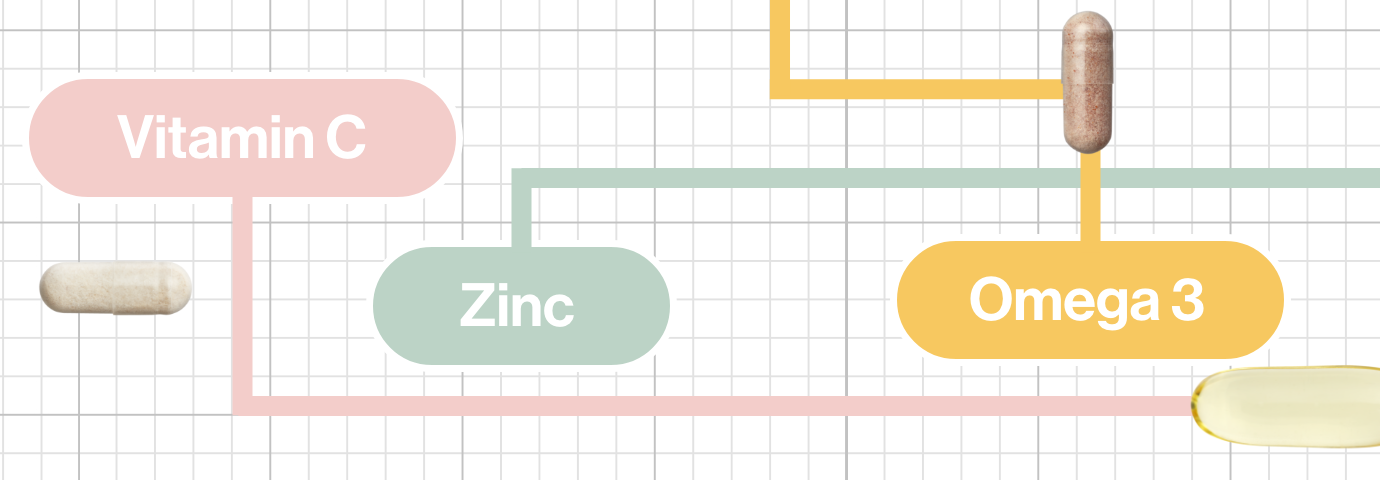Ingredient Spotlight: Perfect Pairings

Not all ingredients work well together. So, knowing the right nutrients to include in your oral skincare can work wonders for your complexion. Our skin researchers have compiled a list of the essential skin-loving ingestible ingredients and perfect pairings you should incorporate in your skin supplement regime today.
Vitamins C and E
Vitamin C is known for its glow-giving, radiance-revealing powers and is an essential nutrient in the body and for the skin. It helps protect the body from free radical damage and support collagen formation* - making it a co factor in building resilient collagen and a youthful appearance. Vitamin C is stored naturally in the skin, but is depleted quickly, this means that all the vitamin C in our bodies must be taking orally or applied topically.
Vitamin E is a fat-soluble and a key nutrient, that comes with anti-inflammatory properties. Furthermore, vitamin E helps with cell function and as it’s an antioxidant, it also makes it effective for helping combat free radicals and protect cells from oxidative stress**.
Working together, these key antioxidants are great examples of vitamins working in synergy together as vitamin C helps to regenerate vitamin E, so it can contribute to fighting free radicals. In addition, research has shown when taken together they can help minimise skin damage from too much UV exposure[1].
Zinc and Vitamin A
Zinc is a vital nutrient for your body, it plays a role in hundreds of body biochemical reactions including digestion, immunity and cognitive function. Our bodies can’t produce or store it, so we need to consume regular sources. What’s clear from research, is that zinc has multiple benefits for the skin including benefiting overall skin health** and the production of new skin cells.
Working in synergy together, zinc and vitamin A are the perfect partners. Zinc helps to transport and convert vitamin A to the most useful form [2].So, it’s clear why these two ingredients should be skincare staples in your supplement regime.
Omega 3 and Hyaluronic Acid
Omega-3 fatty acids are important fats that you can only get from your diet. Studies show not only do they bring benefits to your body and brain but to your skin as well. One of the key benefits to the skin, are they help play a part in balancing oil production to result in hydrated-looking skin[3]. They have also been shown to help with skin redness[4].
Hyaluronic acid is naturally produced by our bodies to keep our skin, tissues, and eyes well moisturised. It’s more commonly known as the ingredient associated with fillers and botox. However, we’ll let you in to a secret, taking them orally, keeps your skin looking and feeling more supple as it increases the amount of moisture in the skin, preventing dryness and flakiness. So, taking them orally should be considered to reap in all these amazing benefits.
Combining these two hydration heroes together can help aid skin health***with the added moisturising benefits from omega-3 fatty acids, plus plumping of hyaluronic acid can leave your skin looking volumised and youthful – win-win!
It can all sound like a bit of a minefield when it comes to which ingredients work well together, but once you know the vitamins that work in synergy together your skin supplement regime will be a breeze. Trust the skin experts from Advanced Nutrition Programme™ to help put your best skin forward.
*Vitamin C contributes to normal collagen formation and protects cells from oxidative stress
**Vitamin E contributes to the protection of cells from oxidative stress
*** Vitamin A contributes to the maintenance of normal skin
Sources
- Partners in defence, Vitamins E and C. A C Chan. September 1993.
- Interactions between zinc and vitamin A: an update. The National Library Of Medicine. P Christian, K P West Jr. August 1998.
- Healing fats of the skin: the structural and immunologic roles of the ω-6 and ω-3 fatty acids. Science Direct. MeagenM.McCusker, MDJaneM.Grant-Kels.
- Omega-3 Polyunsaturated fatty acids: photoprotective macronutrients. National Library of Medicine. Pilkington S, Watson, R, Nicolaou A, Rhodes L. MA
